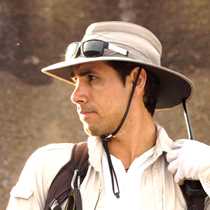Today, we visited Genovesa (also known as Tower) island, home to the largest population in the world of many types of seabirds. There were many highlights throughout the day, ranging from a Nazca booby guarding its egg to seeing a large stingray sleeping on the seafloor, including red-footed boobies, seagulls, owls, fur seals, and sharks.
Early morning, some people went kayaking. After breakfast, we started the main activities of the day. Due to Genovesa Island’s ecological fragility, we had to split up into two groups to see the island and reduce stress on the wildlife. For me, the first excursion was a dry landing at Prince Phillip’s steps. After a steep climb up 90 feet of natural steps, we were surrounded by Nazca boobies, red-footed boobies, and frigate birds. We were very lucky to have an elusive short-eared owl land on the trail with its storm-petrel prey in hand. We also saw a massive group of frigate birds and boobies flying in the sky, diving for fish. In addition, we saw Nazca boobies guarding their eggs, as well as boobies choosing nesting sites. After a short break, we had the opportunity to kayak, snorkel, or paddleboard around Darwin Bay. I chose to snorkel and saw an amazing variety of fish, including king angelfish and many butterflyfish. We saw a shark swimming in the distance. Personally, this trip was my first time snorkeling and completely exceeded my expectations. This week’s snorkeling will likely make snorkeling in other places an inferior experience for me, as I will always compare them to this life-changing experience.
After the excursion, we hung our wetsuits and snorkeling gear for the last time. We attended Expedition Leader Carlos’s least popular talk: the departure briefing. Then, we had a tasty buffet lunch with food from the Galapagos Islands, before continuing with the activities of the day. The next excursion to the island was a wet landing at Darwin Bay at a white coral pebbled beach. In a very inspiring moment, we saw dozens of juvenile red-footed boobies take their first flight to go fishing. After this, we walked knee-deep in a trail that had become flooded due to high tide. We got close to the mangroves, where we had the opportunity to see red-footed booby nests. In the shallow water, we saw a small stingray. After this, we saw many gulls and boobies on the beach and got the rare opportunity to see a sea lion in labor. Unfortunately, we had to leave before the baby sea lion was born.
We left Genovesa Island with heavy hearts, being the last chance we had to see the Galapagos Islands. Looking back on the expedition, it was truly a once in a lifetime experience. We felt a real connection with the wildlife we saw, and the memories made here will stay with us for the rest of our lives. The Galapagos Islands are a truly unique place, where wildlife is not scared of you and occasionally deliberately comes near to you, an experience that has to stay with you for a long time.









